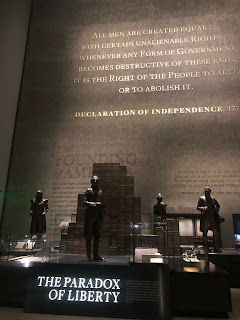National Museum of African American History and Culture
Today I went to the National Museum of African American History and Culture with the Saint Albans Program here in Washington, D.C. We had the amazing opportunity of going on a private docent-led tour through the years spanning from the 1400s all the way to modern times, highlighting the unique African-American experience. And, as the docent clarified, the exhibits were not simply "Black History," but instead they were recounting American History from the African-American lens.
The first exhibit we toured highlighted the developments in early African states prior to European arrival. As we walked through the cramped space, we came upon that dreadful point, shackles and all, and learned about the "The Paradox of Freedom," as Africans travelling to the New World and eventually, a newly-declared independent country of the United States. Yet, they were anything but free, seemingly contradictory to their white counterparts.
As we progressed through the museum, and through time, we learned of the various cruelties to which African-Americans were subject. From lashes to lynchings, Frederick Douglass to the Little Rock 9. We discussed the stereotypes used to subjugate African-Americans and their pervasiveness throughout history.
We furthermore learned about the Civil Rights movement and how it helped push forward international efforts like the Chicano Movement.
Finally, we learned about African-Americans taking center stage and becoming markers of diverse American pop culture in professional athletics, music, and television, uniquely contributing to the melting pot after emerging from a harsh past.
All in all, the African and African-American experiences both in and Out of America reflect the resilience of these people and hat humanity transcends race and color.
The first exhibit we toured highlighted the developments in early African states prior to European arrival. As we walked through the cramped space, we came upon that dreadful point, shackles and all, and learned about the "The Paradox of Freedom," as Africans travelling to the New World and eventually, a newly-declared independent country of the United States. Yet, they were anything but free, seemingly contradictory to their white counterparts.
As we progressed through the museum, and through time, we learned of the various cruelties to which African-Americans were subject. From lashes to lynchings, Frederick Douglass to the Little Rock 9. We discussed the stereotypes used to subjugate African-Americans and their pervasiveness throughout history.
We furthermore learned about the Civil Rights movement and how it helped push forward international efforts like the Chicano Movement.
Finally, we learned about African-Americans taking center stage and becoming markers of diverse American pop culture in professional athletics, music, and television, uniquely contributing to the melting pot after emerging from a harsh past.
All in all, the African and African-American experiences both in and Out of America reflect the resilience of these people and hat humanity transcends race and color.







What a powerful experience to take with you into your global work next year and beyond! Terrence Roberts, from Little Rock 9, lives in Pasadena and has come to speak at Poly. Perhaps you can partner with others to bring him back.
ReplyDelete